|
 Secure Site
Secure Site
|
 |
Archive for October, 2012
 a mediation practice can be done anywhere and anytime Everybody needs a sanctuary, a place to rest and renew. The beauty of meditation — a proven and profound form of self-care for mind and body — is that almost anytime, anywhere, you can access that place of restorative calm.
Yet for some, meditation sounds mysterious or intimidating, probably because of some common misconceptions: that it’s dry or boring or “too spiritual”; that it’s an esoteric practice for those operating on some higher, more rarefied plane.
Yes, meditation is an ancient spiritual practice — one that cuts across different religions and many different traditions. But what it boils down to — however it’s practiced and whatever form it takes — is this: To meditate simply means to rest in moments of appreciative, exquisite attentiveness. Moments that allow us to savor the experience of living and that make us feel both deeply calm and deeply alert, in tune both with our self and with the world around us. Moments we come away from feeling refreshed, renewed, and engaged. Meditation is a way of communing with spirit.
 meditate under tree We all know how to meditate; it’s an instinctive ability. If you’ve ever been deliciously absorbed gazing at the flow of a river, the dance of a fire, or the twinkle of stars, you’ve enjoyed meditative moments. And you can create those moments almost anywhere at any time. If you have a favorite place in your home in which to meditate, that’s wonderful. But you can meditate just as effectively sitting at your desk or on a park bench, or lying in the grass. The fact is, the juicier and more sensual you let meditation be, the more you will get out of it.
Meditating on a daily basis is easy. Give yourself a space of time — 10 to 20 minutes morning and afternoon, or if that’s not possible, a few minutes here and there throughout the day. Set your Bamboo Zen Meditation Timer for a at least 5 minutes. Choose a pleasing, peaceful focus for attention — sensations, such as the flow of your breath; a sound you make, such as ahhh; or a visual image, such as waves coming to shore. This is your home base. Lightly focus your attention, and when your mind wanders off, gently come back to home base. Minds wander — a lot. So go easy on yourself and accept the process.
Although meditation can be done in almost any context, practitioners usually employ a quiet, tranquil space, a meditation cushion or bench, and some kind of timing device to time the meditation session. Ideally, the more these accoutrements can be integrated the better. Thus, it is conducive to a satisfying meditation practice to have a timer or clock that is tranquil and beautiful. Using a kitchen timer or beeper watch is less than ideal. And it was with these considerations in mind that we designed our digital Zen Alarm Clock and practice timer. This unique “Zen Clock” features a long-resonating acoustic chime that brings the meditation session to a gradual close, preserving the environment of stillness while also acting as an effective time signal.
adapted from Body + Soul Magazine, June 2005 by Lorin Roche and Camille Maurine
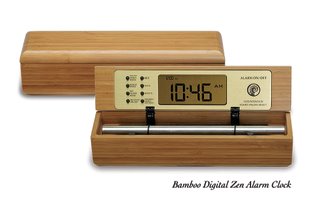 Bamboo yoga and meditation timer, designed especially for meditation practitioners Now & Zen’s Chime Timer and Alarm Clock Store
1638 Pearl Street
Boulder, CO 80302
(800) 779-6383
Posted in intention, Meditation Timers, Meditation Tools, mindfulness practice, Now & Zen Alarm Clocks, Well-being, Zen Timers
 Benefits of Sleep Wake up! New research reported by the American Association for the Advancement of Science shows that sleep is one of the brain’s most powerful tools for learning and remembering. University of Chicago researcher Daniel Margoliash found evidence that young birds practice singing while they sleep: Brain cells active during waking hours showed similar firing when the baby birds napped. “Birds dream of singing,” Margoliash says. And after navigating a spiral maze all day, rats apparently dream of running. Matthew Wilson of the Massachusetts Institute of Technology reported that the sleeping rodents’ brains replayed electrical signals characteristic of running. In human laboratory experiments, students who were tested and then allowed to sleep before retesting showed consistent improvement.
In fact, Robert Stickgold of the Massachusetts Institute of Technology reported that a period of sleep between tests resulted in a 20% boost in performance without additional training, and “the more sleep the students got, the more they improved.” Says Stickgold, “Modern life’s erosion of sleep time could be seriously short-changing our education potential.” He says that “cramming all night may help you pass a test, but if you want to remember any of it after college, you need to sleep on it.”
adapted from Natural Solutions, Aug, 2002
Boulder, Colorado—an innovative company has taken one of life’s most unpleasant experiences (being startled awake by your alarm clock early Monday morning), and transformed it into something to actually look forward to. “The Zen Alarm Clock,” uses soothing acoustic chimes that awaken users gently and gradually, making waking up a real pleasure. Rather than an artificial recorded sound played through a speaker, the Zen Clock features an alloy chime bar similar to a wind chime.
What makes this gentle awakening experience so exquisite is the sound of the natural acoustic chime, which has been tuned to produce the same tones as the tuning forks used by musical therapists. According to the product’s inventor, Steve McIntosh, “once you experience this way of being gradually awakened with beautiful acoustic tones, no other alarm clock will ever do.”
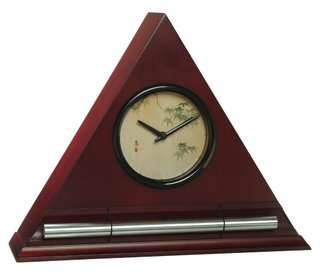 Chime Wake Up Clock by Now & Zen Now & Zen’s Chime
Alarm Clock Store
1638 Pearl Street
Boulder, CO 80302
(800) 779-6383
Posted in Bamboo Chime Clocks, intention, Natural Awakening, Now & Zen Alarm Clocks, Sleep Habits, Well-being
 Morning You don’t have to be a naturally early riser to enjoy all that the morning has to offer. With the right perspective and a few small adjustments, you can turn your morning into one of the most relaxing and energizing parts of your day.
“The morning has incredible potential,” says Alison Novie, senior yoga instructor at Kula Yoga in Manhattan. “I think of the new day as a new year — a whole new life. If you could modify just a few things about your morning, it would change the way you see your day.”
To some degree, you don’t have much choice about how you feel when the sun comes up. Not everyone is born a morning person. But that doesn’t mean your mornings can’t change for the better. It’s worth tinkering with your natural inclinations to reap the rich rewards.
Quiet, full of expectation, yet uncluttered by conversation and untouched by the demands of the day, the morning presents an opportunity for you to find joy, peace, and strength — or at the very least, the chance to ease into the flow so that you aren’t thrown into your day headlong and half awake. We’ve spoken with a renowned sleep expert, a yoga instructor, and a Reiki healer for their insights on everything from getting a good night’s sleep to practicing mind/body awareness to incorporating a sense of play early in the day. Their strategies work well together or individually. Find the ones that work for you, and enjoy them in and around your current morning chaos, whether you live alone, with two dogs, or with five kids. By taking the time to stimulate your senses and relax your body and mind, you’ll start out calmer, more energized, and better prepared for whatever lies ahead.
Reset Your Natural Alarm
First things first: You’ll never enjoy the morning if you don’t get a good night’s sleep. For some people, that means a solid nine hours of uninterrupted slumber; for others, seven hours of shut-eye will do. Sleep expert James B. Maas, Ph.D., author of Power Sleep, notes that eight hours of sleep is the average — but only an average, not a rigid goal. When you’re not getting enough sleep, you’re the first to know. Shifting your sleep schedule is possible, says Maas, but it requires commitment. “If you’re a night person, and you want or need to become a day person, you can do it, but you have to be serious about it. You can’t flip-flop,” he advises. Here’s how to alter your habits in favor of an earlier (and happier) morning.
Make a gradual shift. If you find it hard to fall asleep at night, take things slowly when it comes to establishing a new time for bed. Try hitting the hay five minutes earlier each night, and in less than two weeks you will have shifted your bedtime by one hour.
Resist the urge to snooze. Hitting the snooze bar is an exercise in futility — and torture. You’ll get at best 5 or 10 minutes of fragmented sleep, notes Maas, and may arise feeling groggier than when your alarm first went off. Instead of sneaking in 10 more minutes of sleep, try going to bed 10 minutes earlier instead.
Expose yourself to bright daylight. This is one of the best and most effective things you can do to wake yourself up, says Maas. By opening the curtains and the windows or getting outside, you cue your brain to repress the production of melatonin, the hormone that regulates sleep. Natural daylight works best, but if you get up before sunrise or simply can’t get enough natural light, consider using a sun-mimicking device as an alternative.
Don’t lose sleep over exercise. While you may choose to exercise in the morning, Maas recommends against sacrificing sleep for it. “Never truncate your sleep in order to work out. This puts you at a greater risk of injury,” he advises. Only when you have had enough uninterrupted hours of sleep should you think about getting up to exercise.
 Chime Alarm Clocks and Meditation Timers - Mother and daughter Harunobu Be consistent. “You don’t get two biological clocks — one for weekdays and one for weekends,” says Maas. “That means you have to stick by one.” Sleeping late on the weekends to compensate for lack of sleep during the week will throw you off, making Monday mornings even worse than they need to be. While keeping a consistent sleep schedule is ideal, it’s not always reasonable or practical. Your best bet is to try to keep your schedule fairly regular (that is, getting up and going to bed within an hour or so of your weekday schedule).
Plan your evenings. How you wind down the day may affect the quality of your sleep — and therefore the quality of the following morning. For some, eating a chocolate bar, watching a dramatic movie, or arguing right before bed will be enough to derail sleep. Be aware of your particular sensitivities; avoid those things you know will keep you up.
Boulder, Colorado—an innovative company has taken one of life’s most unpleasant experiences (being startled awake by your alarm clock early Monday morning), and transformed it into something to actually look forward to. “The Zen Alarm Clock,” uses soothing acoustic chimes that awaken users gently and gradually, making waking up a real pleasure. Rather than an artificial recorded sound played through a speaker, the Zen Clock features an alloy chime bar similar to a wind chime. When the clock’s alarm is triggered, its chime produces a long-resonating, beautiful acoustic tone reminiscent of a temple gong. Then, as the ring tone gradually fades away, the clock remains silent until it automatically strikes again three minutes later. The frequency of the chime strikes gradually increase over ten-minutes, eventually striking every five seconds, so they are guaranteed to wake up even the heaviest sleeper. This gentle, ten-minute “progressive awakening” leaves users feeling less groggy, and even helps with dream recall.
adapted from Body +Soul Magazine, March 2006
Now & Zen’s Chime Alarm Clock Store
1638 Pearl Street
Boulder, CO 80302
(800) 779-6383
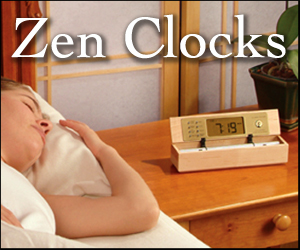 Chime Alarm Clocks - The Digital Zen Alarm Clock
Posted in Chime Alarm Clocks, Natural Awakening, sleep, Sleep Habits, wake up alarm clock, Well-being
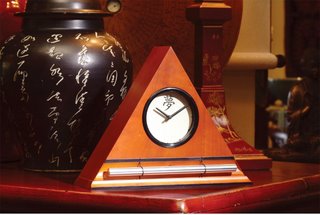 Zen Alarm Clock Zen Awakening
Is waking up to a blaring alarm really necessary? Now & Zen founder Steve McIntosh thought there had to be a better way, so he invented alarm clocks with soft, repeating chimes that wake sleepers gently. “Unlike every other alarm clock on the market, these wake you up with an acoustic sound, not a recorded one,” he says. Referring to notes on the musical scale, he adds, “You hear either an E-toned chime bar or a B-tone, the same sounds used by musical therapists.”
Unlike the snooze button, which jerks you awake again and again, Now & Zen clocks wake you gradually. “The first chime sounds, and then it’s silent for the next three and a half minutes,” McIntosh explains. “Over 10 minutes, the chimes become closer together.”
McIntosh says satisfied customers include notoriously hard-to-wake teenagers—and their parents.
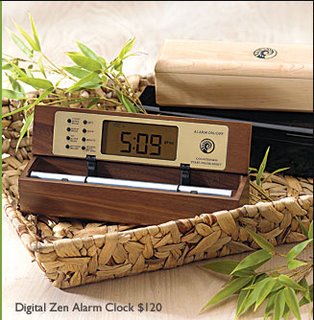 Digital Zen Alarm Clocks and Timers, available in maple, walnut, bamboo, and black lacquer Now & Zen Digital Zen Alarm Clock in natural wood or bamboo case: $110 for B tone; $120 for E tone. (800) 779-6383
adapted from Natural Home Magazine, November/December 2009
Now & Zen – The Zen Alarm Clock Store
1638 Pearl Street
Boulder, CO 80302
(800) 779-6383
Posted in Bamboo Chime Clocks, Chime Alarm Clocks, Japanese Inspired Zen Clocks, Natural Awakening, Now & Zen Alarm Clocks, Progressive Awakening
 meditation practice can be done anywhere and anytime Meditation: Heart Warming
Time: 5 to 20 minutes.
When and Where: Anytime, although the end of the day is nice. Try to find a cozy place.
Position: Set your Zen Timer to 5 to 20 minutes. Sitting comfortably or lying down, eyes open or closed.
Intention: I am awake to love. I am ready to give and receive.
In this meditation you give yourself time to feel the emotional impact of all that is in your heart. Be leisurely, and linger in any of the meditation’s phases for as long as you like.
1. Begin by thinking of someone or something you love without reservation. Notice the sensations that arise in your heart and let yourself be with whatever is there — warmth, aching, joy, longing.
2. Bring both hands to your heart, feeling the warm contact of your palms against your chest. Imagine your heart being warmed by your love, melting any cold places, any part of you that is afraid, grieving, or lonely.
3. Make a humming sound, such as ahhh or ohhmm. Enjoy the way the sound vibrates in your chest for as long as you like. Then gradually let the sound fade away; you can return to it at any time.
4. Again notice the contact of your hands on your heart. Slowly open your arms outward, as you would to embrace someone. Take a few breaths and then slowly bring your hands back to your chest. Repeat this movement several times with great leisure. The simple motion of opening to give and drawing in to receive is a yoga of the heart, a way of expressing balance. End by bringing your hands back to your heart; pause, savoring the sensations and feelings.
Benefits of Meditation
– Promotes relaxation
– Enhances health
– Cultivates vitality
– Fosters clarity
– Increases focus
– Reduces stress
Use our unique “Zen Clock” which functions as a Yoga & Meditation Timer. It features a long-resonating acoustic chime that brings your meditation or yoga session to a gradual close, preserving the environment of stillness while also acting as an effective time signal. Our Yoga Timer & Clock can be programmed to chime at the end of the meditation or yoga session or periodically throughout the session as a kind of sonic yantra. The beauty and functionality of the Zen Clock/Timer makes it a meditation tool that can actually help you “make time” for meditation in your life. Bring yourself back to balance.
adapted from Body + Soul Magazine, June 2005 by Lorin Roche and Camille Maurine
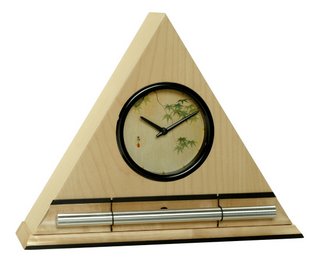 Japanese Maple Leaves Dial Face, the Zen Alarm Clock and Timer Now & Zen- Meditation Timer & Alarm Clock Store
1638 Pearl Street
Boulder, CO 80302
(800) 779-6383
Posted in Bamboo Chime Clocks, intention, Meditation Timers, Meditation Tools, mindfulness practice, Now & Zen Alarm Clocks, Zen Timers
 Decluttering a bedroom space, Digital Zen Alarm Clock What’s the first space in your home that experts recommend tackling when you declutter? If you said the living room, kitchen or foyer, guess again. It’s the bedroom.
“I always start with the bedroom,” says feng shui consultant Andrea Gerasimo of Menomonie, Wisconsin. “It’s your sanctuary.” Gerasimo cites studies showing that what you’re thinking when you nod off affects how you sleep and your mood when you wake up. So if your last mental image is of chaos and clutter, you’re not setting the right stage for quality sleep.
In your bedroom space, do you trip over piles of clothing, boxes, shoes and assorted tchotchkes? Are stacks of DVDs careening from your bedroom entertainment center? Or, perhaps you’ve placed your home office—with its tangle of computer and phone lines, file folders, sticky notes and miscellaneous office supplies—in your sleep space.
The good news is that you don’t have to remodel to streamline your bedroom.
Rearranging furniture (even better, removing a few items), decluttering and adopting a resolute mindset to keep your bedroom space harmonious and clutter-free are simple steps that can make a big difference.
Transform your bedroom from cluttered chaos to serene retreat with these easy tips.
1.Furniture: Less is More
Having too many dressers, tables and chairs jammed into a space—no matter how large—makes it feel smaller. And stuff attracts more stuff. As we add more pieces, we tend to fill them, inside and out.
Solutions:
■ Invite a friend with a fresh set of eyes over for a streamlining session. Move everything out, then open your mind to new arrangements. Bring in the pieces you love most until the room seems adequately furnished but not overly stuffed; the remaining furniture is probably unnecessary. Choose a Zen Alarm Clock for the space next to you bed on your table. Pick the Digital Zen Alarm Clock that has a lid that can be closed to further declutter your bedroom space.
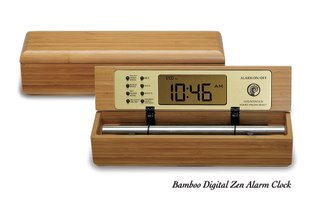 Bamboo Digital Chime Clock, closing the lid to the clock helps declutter your bedroom space ■ Think about what you can donate, use elsewhere or sell. Candidates for the chopping block may include exercise equipment, a dresser, even your television. Family manager coach Beth Dargis of Holland, Michigan, singles out dressers as occupying too much space in a room. (What’s more, their long, low surfaces invite clutter, she says.) Whenever possible, Dargis recommends replacing a dresser with a highboy, which holds roughly the same number of items but with a smaller footprint.
■ While everything is out of the room, consider spiffing up your walls with a fresh coat of no- or low-VOC paint (VOCs are volatile organic compounds that outgas into the air). If you want to change your window treatments to hemp or organic cotton, this is an ideal time. At the very least, give your bedroom a good, thorough cleaning before moving furniture back in.
2.Clothing: The Hidden Culprit
Anytime you declutter a bedroom, you invariably run into a surfeit of clothing, shoes and accessories. This accumulation is the root cause of a number of ills. “People cram in another piece of furniture instead of going through their wardrobes and getting rid of what no longer fits,” says New York interior designer John Loecke, author of the Organizing Idea Book (Taunton, 2006). Many times, Loecke has seen couples introduce substantial armoires to their bedroom space to accommodate one person’s wardrobe because the other’s has overtaken the closet.
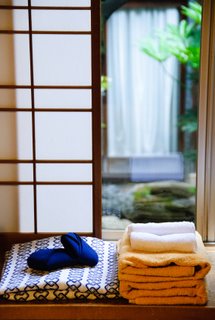 zen-like bedroom Solutions:
■ First, simply pare down. Set aside half a day (with a decluttering buddy, if you can find one) and go through your wardrobe ruthlessly, donating what no longer fits, what you haven’t worn in a year or two, and what’s outdated. Take everything out of the closet and put it in piles to donate or consign, trying on only the items you aren’t sure about. (In the process, I guarantee you’ll discover at least one “treasure” that you’ll want to reclaim!)
■ Once you’ve whittled down your wardrobe, adopt a practice I’ve been following for years. Put two containers in your closet: one for donation, one for consignment. As soon as I wear an item and decide it’s no longer for me, I place it directly into one of the boxes. As soon as one fills, I pop it in my car and drop it off at my charity or resale shop.
■ Once you’ve reduced your holdings, you’ll be surprised at the amount of space you’ve freed up. Before you begin to reload, take this moment to sort everything by category—separate all shirts, dresses, pantsuits and tops into categories. Organize shirts and blouses according to color, from light to dark, or by use, such as dress shirts and T-shirts. This system helps you see what you have. (If you still have more than your closet will bear, and if you have a climate-controlled attic or basement space, you can rotate out-of-season items.)
■ To further streamline, remove as much as possible from the closet floor. A hanging shoe rack helps get shoes up and in sight. The same goes for ties, belts, scarves and hats. As you organize your wardrobe, it’ll be easier—and obvious—to see what you have and which items to chuck.
3. Streamline Bedding
Sometimes the bed itself—including all the attendant bedding and pillows—can create visual clutter.
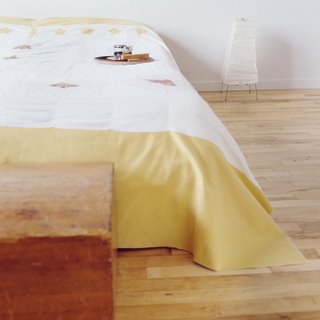 how to declutter your bedroom space
Solutions:
■ Bed size—like just about everything else in America these days—has become supersized. But do you really need a king-size bed? When you’re shopping for your next bed, consider scaling back and opting for a smaller model—if not a full, then try a queen.
■ Also consider streamlining your bedding, says Lisa Quinn, San Francisco-based
interior designer and author of $500 Room Makeovers (Clarkson Potter, 2006). Instead of feathering your nest with brightly colored, matched bedding sets, why not go for basic whites or plain pieces in a limited color palette? If you spill red wine on your butterflies-in-flight pillowcases—or if your zebra-print bottom sheet fades more quickly than the flat—you’ll probably have to discard the entire set to achieve harmony. Plain pieces are interchangeable; you can simply make up any loss with a generic replacement. You also can pick up spare linens at thrift shops and consignment stores. “If your bedding is all white,” Quinn says, “it can take so much off your plate!”
■ Instead of piling on the pillows, pare down to only those you actually use. It makes for a Zen-like bed, and you don’t have to juggle all the extra “show” pillows when you get into bed at night.
4. No Place for Your (Home) Office
Your bedroom should be a pleasure palace or at least a haven for sleep and retreat—not a place where you pay bills, haggle and hassle.
Solutions:
■ If you’ve placed your home office in your bedroom space, try to issue an eviction notice. Any place in the house—including the kitchen, dining room or guest room—is better than your bedroom. A friend in Los Angeles converted a garden shed into a home office, giving her physical separation from her house and a discreet space to do her work as a freelance writer. Another enterprising Los Angeles friend (also a writer) bartered five hours a month of her writing and public relations services in exchange for free space in a lawyers’ office. They even threw in use of their copier.
■ If you see no other solution than putting your office in the bedroom, choose a place where you can shut the doors, such as a closet or computer armoire. Being able to physically close off your home office will help promote peace of mind and better sleep, which, in turn, will make you more productive when you work.
Daily Rituals
These rituals will improve your bedroom’s serenity quotient.
1. Make your bed every day—preferably when you get up in the morning and before you do anything else.
2. Open your draperies or blinds to let the sun shine in.
3. When you come home at the end of the day, hang your clothes or place them in the laundry basket. Avoid the temptation to drape them on a chair.
4. To avoid bedside clutter, keep just one of everything out: the book you’re reading; one bottle of lotion; one pair of slippers.
5. Finally, scrutinize every new item that you introduce into your bedroom. You can avoid the problem of accumulated clutter by making conscious choices in the first place.
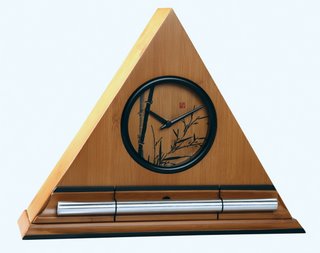 Bamboo Zen Clocks, progressive chime clock and timer adapted from Natural Home Magazine, November/December 2009 by Wanda Urbanska
Now & Zen – The Zen Alarm Clock Store
1638 Pearl Street
Boulder, CO 80302
(800) 779-6383
Posted in Bamboo Chime Clocks, Chime Alarm Clocks, Japanese Inspired Zen Clocks, Natural Awakening, Now & Zen Alarm Clocks, Sleep Habits, Well-being
 connect with nature in the morning Mornings are sacrosanct for Reiki master and energy healer E. Barrie Kavasch, a descendent of the Cherokee and Creek tribes and author of more than 15 books on Native American culture, including The Medicine Wheel Garden. “Our own internal wisdom knows this,” Kavasch explains. “We come from origins that tell us we should be up and about.” Growing up on a family farm in Tennessee, Kavasch and her siblings would wake up before dawn to milk the cows. “Our days would be filled with energy and enthusiasm. We would have done so much by 8:30 a.m.,” she says. “I can’t imagine a morning without being in close touch with nature.” Even those not living on a farm can gain from the enlivening benefits nature will bring to the tired human body.
Step outside. In many ways, getting outdoors provides the best way to get your mind and body in sync with the morning. “The first thing I do each morning is get up and go out for a walk. I fill my lungs with the morning air,” says Kavasch. Even if you don’t have time for a walk, simply stand out in the morning light to get connected with the world around you.
Open a window. If you can’t get out, bring the fresh air in. Pull open the blinds and open a window to let in the light, smells, and sounds of a new day.
See blue. Among the Pueblo and Navajo people, says Kavasch, seeing turquoise first thing in the morning is considered a blessing. This helps explain why they’ll often paint a portion of their windowsills or door frames in this brilliant color. “Turquoise is considered a sky stone, reminding us of when the sky is at its brightest and sunniest,” says Kavasch. “To see it upon first opening your eyes is a blessing for the hours that follow.” To set the stage for a better morning, try keeping a turquoise stone, bracelet, necklace, or colored item by your bedside or in your window so you see it first thing in the morning.
Water your plants. Invite nature into your home by placing houseplants throughout; then take time each morning to water and care for them. Just touching and focusing on this element of nature can gently draw you into the new day.
Enjoy a taste of nature. A bite of fresh fruit or a sip of juice can recall a vital connection to the natural world and help gently awaken your senses. Think of that taste as more than food; it represents nature’s bounty.
Waking up in the morning should be as pleasant as falling asleep at night. The Zen Alarm Clock’s gradual, gentle awakening is transformative.
Boulder, Colorado—an innovative company has taken one of life’s most unpleasant experiences (being startled awake by your alarm clock early Monday morning), and transformed it into something to actually look forward to. “The Zen Alarm Clock,” uses soothing acoustic chimes that awaken users gently and gradually, making waking up a real pleasure.
adapted from Body + Soul, March 2006
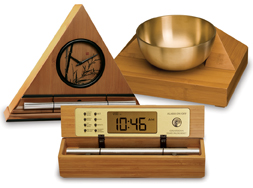 Singing Bowl and Chime Alarm Clocks and Timers Now & Zen’s Soothing Chime Alarm Clock
1638 Pearl Street
Boulder, CO 80302
(800) 779-6383
Posted in Chime Alarm Clocks, Now & Zen Alarm Clocks, Progressive Awakening, sleep, Sleep Habits
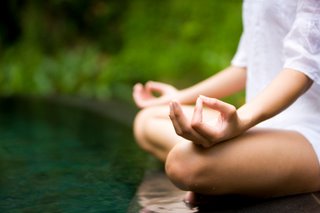 Meditation Pose, centering prayer Going through a divorce, my world was askew. Physically, I was paying attention to my core with exercise, but emotionally I was a wreck. When my yoga teacher, Claudia, who was also a Benedictine oblate at Holy Wisdom Seminary, told me about Father Thomas Keating and the Centering Prayer movement I wanted to be open. Keating (along with other Trappist monks) brought the concept to the American public in the mid 1980s, reviving a practice that had been prominent during the first sixteen centuries of Christianity. During the Reformation, this mystical experience was discarded in favor of Rationalism and it wasn’t until the Western World discovered Buddhist meditation that it became popular again.
The goal of Centering Prayer is to know God’s love and feel God’s grace. To do so, you must get quiet, focus on a sacred word of your choice, and relax and enjoy the moment. The result—at least sometimes—a mystical experience. What’s not to like?
Well, for me, the God stuff was a problem. Having left organized religion, I wasn’t sure I believed in prayer or God. But when seeking inner peace, it’s hard to ignore the value of prayer to comfort. Meditation is one path to serenity, said Claudia; prayer is another. They both calm the mind and open the heart.
I met Claudia in her meditation studio. Sitting cross-legged on a cushion, she struck a chime and had me repeat after her: “Be still and know that I am love” (a slight modification of Psalm 46:10). “Be still and know.” “Be still.” “Be.”
I tried to clear my mind of thoughts, focusing only on the sacred word I chose. I tried “Home,” thinking it is so close to “Om” that it will be easy to find my meditation point. Nothing. Then “Freedom,” “Peace,” “Nothingness.” Finally, I settled on the word “Divine,” and fell through time and clouds into a space where I felt comforted. Then the chime sounded. Twenty minutes had passed.
I didn’t know where I had been—it was like I had found a silent sanctuary in my mind that was there all along. Claudia says entering into Centering Prayer is similar to falling in love—all boundaries collapse and you feel authentic and fearless. The real payoff is in the regular practice of Centering Prayer. Knowing you will be calmed and comforted in the loving arms of the universe is a sweet retreat at the beginning or end of a day.
Although meditation can be done in almost any context, practitioners usually employ a quiet, tranquil space, a meditation cushion or bench, and some kind of timing device to time the meditation session. Ideally, the more these accoutrements can be integrated the better. Thus, it is conducive to a satisfying meditation practice to have a timer or clock that is tranquil and beautiful. Using a kitchen timer or beeper watch is less than ideal. And it was with these considerations in mind that we designed our digital Zen Alarm Clock and practice timer. This unique “Zen Clock” features a long-resonating acoustic chime that brings the meditation session to a gradual close, preserving the environment of stillness while also acting as an effective time signal.
adapted from Healing Lifestyles & Spas, by Judy Kirkwood, 2010
 Zen Chime Alarm Clock and Timer Now & Zen’s Meditation Timer Store
1638 Pearl Street
Boulder, CO 80302
Posted in Bamboo Chime Clocks, intention, Japanese Inspired Zen Clocks, Now & Zen Alarm Clocks
 zen-like bathroom retreat
Sometimes, in the words of William Wordsworth, “the world is too much with us.” There’s so much happening, so much to do. How do we stay sane?
Take a sensual bath.
“Frequently people look at the bathroom as a refuge or day spa for themselves,” says Jules Lambert, a kitchen and bath designer for DreamMaker Bath & Kitchen in Bellingham, Washington. “It’s a place they can escape from the kids, the television, the phone, their work.”
Ask people what their ideal bathroom would look like, and the details are delicious. “It would have a stone tile floor and a pebble composite-type sink with lots of natural light,” says Heather Pike, owner of PikeWorks Design Studios in Walls, Mississippi. “Balance that with a deeply textured rug for crawling out of the big tub, thick Egyptian cotton towels and, of course, candles. Lots of candles. And some fantastic smell, like rosemary, and a tray of gorgeous perfumes and soaps that I would use for only me. And lace somewhere.”
Sounds yummy, doesn’t it?
The biggest difference between the closet-size bath and the Cleopatra-like opulence is cost—to your pocketbook and to the environment. A full bathroom remodel might range anywhere from $3,000 to more than $20,000, depending on architectural changes, finish materials, and fixtures, and it will involve a hefty amount of natural resources and energy. But with some minor, earth-friendly modifications that introduce inviting colors, textures, and the right accessories, even a basic bathroom can become a personal sanctuary, a sensual space that nurtures the body and soothes the spirit. The key to a sensual bathroom is to remember all the senses.
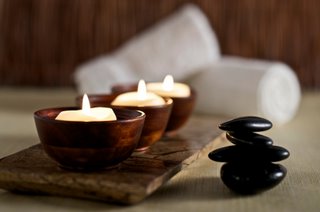 zen-like bathroom retreat Make it warm
“Warmth, warmth, more warmth!” wrote Spanish philosopher Miguel de Unamuno. “It is not the night that kills but the frost.” While a chilly bathroom probably won’t kill you, it doesn’t make for a pleasant sensual bath.
“You’re getting undressed in this room; you want it to be warm,” says Lambert, who frowns on forced-air heating because it “increases the wind chill. Plus, forced-air systems that turn off and on can’t keep surfaces warm.” Ideally, he says, the bathroom should have radiant heat. “That will keep everything in the room at a constant temperature, and the room’s heat will radiate back into your body.”
Towel warmers are another way to achieve radiant heat in the bathroom. Some models, such as Runtal’s Omnipanel, will work as the sole heat source in a bathroom up to 110 square feet. Larger rooms can be heated with two towel-warming units. Cost ranges from $600 to $1,000, depending on size.
Splash on color
Studies show that color can profoundly affect one’s mood, making it an important consideration in any interior design. For a soothing bathroom, consider the color spectrum’s cooler end. Blues generate feelings of tranquility. Greens are associated with calm and healing. Both colors can wax warmer by adding yellow or red undertones.
For a warm atmosphere, yellow, considered highly stimulating, can evoke cheerfulness. Red, suggestive of danger and excitement, arouses some and disturbs others. Ironically, diluted red (pink) is so tranquilizing that it’s now used in some prisons to suppress hostile behavior.
Catherine Hobbs, owner of Studio Frank in Telluride, Colorado, has a conservative approach. “From the designer position, it is important to create a grounded, sustainable background in the space,” she says. “If someone wants a sensual bathroom, I see creams, beiges, greens—colors that create a lighter, brighter feel—bright, but not harsh. For instance, off-white is much more soothing than white-white.”
Connect with the earth
Hobbs prefers natural materials in the bathroom. “We have an attachment to our past on this earth,” she says, “so when we walk into a room that uses materials such as limestone and wood, we get a feeling that is warm and relaxing, even if we don’t know why. In a sensual bathroom, I don’t see anything too glitzy or polished—more things that are raw—things that bring us back to home and to the earth.”
Wood adds warmth, rich color, and texture that can balance the coolness of stone, glass, and metal. Cedar and teak are decay-resistant and better suited to wet areas, but cabinets, wall finishes, even floors can be made from almost any wood if properly protected. As with paints, choose low-VOC finishes.
“And I’d like to see fabric,” Hobbs says. “Raw linen or raw hemp would make nice sheer window coverings. They’d also work well to cover a cushion on a bench or chair if you have room—a comfortable piece lets you really relax and spend some time there.”
The nose knows
One of the least expensive senses to satisfy is the sense of smell. “You can use essential oils to uplift and de-stress,” says Bobbi Lacroix, manager of product development at Green Valley Aromatherapy in Courtenay, BC, Canada. “Geranium is an antidepressant, great for picking you up as opposed to stimulating you. Lavender is calming and soothing. Rose, jasmine, and neroli [from the flower of the bitter orange tree] are aphrodisiacs.”
To use pure essential oils, add four to six drops to running bath water. You can also use a diffuser—warmed either by electricity or tea light candles. “I like using the tea lights so I have the added benefit of the candles—and candles are always a nice part of a sensuous bathroom,” Lacroix says. Select beeswax or soybean candles to keep the air chemical-free.
 Pure essential oils added to a sensual bath For soothing sore muscles, add pure essential oils to Epsom salts—five or six drops of oil to a half cup of salts—then add to running water. Or for post-bath aromatherapy, add one drop of essential oil to one milliliter of sweet almond oil or sunflower oil. Beware of using petrochemical-based oils, such as baby oil, which clog your pores.
As an alternative to oils, fresh flowers in a sensual bath provide both scent and beauty. Pike suggests gardenias—soft and velvety white. “Hyacinth is a good water plant, too,” she says, “with an intoxicating scent. And magnolias, if you can get them, have a rich lemony smell.”
 Orchid with Wood Vase
To help you breathe deeply, you’ll need ventilation to remove stale air and moisture. An operable window is ideal—plus it adds natural light to the room. For windowless rooms, Lambert recommends Panasonic Whisper Lite bathroom fans. “They have low sone ratings—from 0.5 to 1.5. That means very quiet.” Cost is around $300.
Either revel in the near-silence or relax to music. “Music in the bathroom really sets the tone,” Lambert says. “I recommend people run some good wire from their stereo system into the bathroom and install a discreet speaker like the Stealth Speaker System from Dimensional Communications. You can’t even see it—it looks like drywall.”
The secret
High-end bathrooms might also boast spa-like accessories such as jetted tubs, steam showers, and saunas. But the secret to enjoying a sensual bathroom is to make the time to be in it. So lock the door. Draw the bath. Take a deep breath. Now steep.
Flat Towels?
Ever wonder why your organic cotton towels seem to lack the fluffiness you find in those chemical-laden ones? Because cotton is not naturally absorbent, harsh chemicals are often used to add bounce during the finishing process. You can get that feel in untreated organic cotton towels by filling your washing machine with hot water, then adding a detergent that contains washing soda (sodium carbonate) and 1 cup of cider or white vinegar. Soak your towels for one hour, then wash in the same water. Voila! All the fluff— none of the chemicals.
Zen Timer, a Meditation Tool
Remember to add a Zen Clock to your bathroom so that you can end your heavenly soak with a beautiful chime.
 Zen Alarm Clock Sounds for the Bath
Music makes the bathing experience a true retreat because it blocks out distracting noises and transports you to another realm. Here are a few recommendations to enhance your next sensual bath.
For healing
Gabrielle Roth and the Mirrors: Refuge (Raven, 1998)
For relaxation
ad dios: Aquatica—Aspects of Water (www.wellnessmusic.com)
For inspiration
Rafael Toral: Sound Mind Sound Body (Moikai Records, 2000)
For meditation
Krishna Das: Breath of the Heart (Razor and Tie, 2001)
For a natural high
Orb: The Orb’s Adventures Beyond The Ultraworld (Island Red, 1991)
For a dreamy groove
Morcheeba: Big Calm (Sire, 1998)
Use our unique “Zen Clock” which functions as a Yoga Timer. It features a long-resonating acoustic chime that brings your meditation or yoga session to a gradual close, preserving the environment of stillness while also acting as an effective time signal. Our Yoga Timer & Clock can be programmed to chime at the end of the meditation or yoga session or periodically throughout the session as a kind of sonic yantra. The beauty and functionality of the Zen Clock/Timer makes it a meditation tool that can actually help you “make time” for meditation in your life. Bring yourself back to balance.
 Singing Bowl Clocks and Timers for Meditation adapted from Natural Home Magazine, September/October, 2002 by Rosemerry Wahtola Trommer
Now & Zen – The Zen Alarm Clock and Chime Timer Store
1638 Pearl Street
Boulder, CO 80302
(800) 779-6383
Posted in Bamboo Chime Clocks, Japanese Inspired Zen Clocks, Now & Zen Alarm Clocks
 how to increase sleepiness Your body needs to sleep in near-total darkness for optimum health. Darkness prompts the pineal gland to produce melatonin, a hormone that increases both sleepiness and length and quality of sleep. Too much light can compromise melatonin production, interfering with slumber. Some studies have suggested that low melatonin levels may be linked to a higher risk of breast cancer, although the more common result of a too-bright room will be a poor night’s sleep. Use an eye mask or install light-blocking shades over your windows to prevent street lamps — even a full moon — from disrupting your sleep. Products to try: Gaiam’s silk sleep mask (gaiam.com). Be sure to wake naturally in the morning with a Chime Alarm Clock by Now & Zen.
Boulder, Colorado—an innovative company has taken one of life’s most unpleasant experiences (being startled awake by your alarm clock early Monday morning), and transformed it into something to actually look forward to. “The Zen Alarm Clock,” uses soothing acoustic chimes that awaken users gently and gradually, making waking up a real pleasure.
What makes this gentle awakening experience so exquisite is the sound of the natural acoustic chime, which has been tuned to produce the same tones as the tuning forks used by musical therapists. According to the product’s inventor, Steve McIntosh, “once you experience this way of being gradually awakened with beautiful acoustic tones, no other alarm clock will ever do.”
adapted from Body + Soul Magazine, February 2006
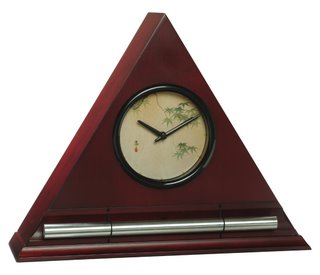 Chime Alarm Clock for a Progressive Awakening Now & Zen – The Zen Alarm Clock Shop
1638 Pearl Street
Boulder, CO 80302
(800) 779-6383
Posted in Natural Awakening, Progressive Awakening, sleep, Sleep Habits, wake up alarm clock, Well-being
« Previous Page — « Previous Entries
Next Entries » — Next Page »
|
|
|
|